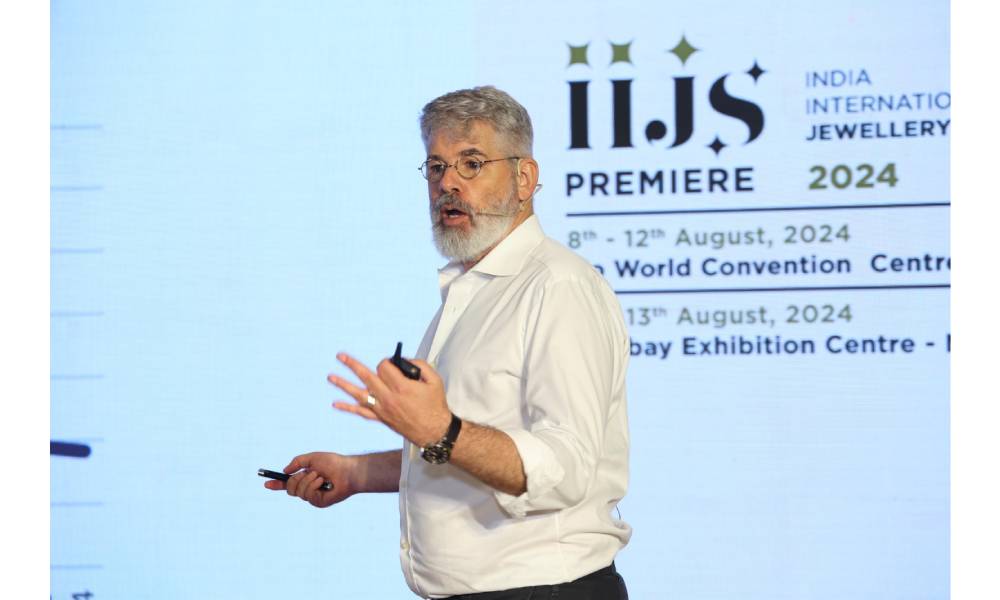Edahn Golan, a prominent diamond analyst, delivered a presentation during an Innov8 Talks session at IIJS Premiere 2024 in Mumbai, that delved into the complexities and current trends within the diamond industry. His insights, based on a combination of data analysis and market observations, paint a nuanced picture of an industry facing both challenges and opportunities. This article summarises and expands on Golan’s key points to provide a comprehensive understanding of the current state and future prospects of the diamond market.
Golan begins by highlighting a significant trend: a consistent decline in diamond production over the past two years. This trend is influenced by various factors, including geopolitical instability, economic downturns, and operational challenges faced by major diamond-producing countries. For instance, Russia’s diamond production has been described as a “black hole,” reflecting the opaque nature of its output figures. Similarly, production in Botswana and other key regions has seen a downturn.
The data suggests that production in 2024 will continue to decline, a trend that has significant implications for the market. Lower production levels often lead to higher prices due to reduced supply, but they also reflect broader economic uncertainties and operational challenges within the industry.
The global diamond trade is characterised by varied dynamics across different regions. Golan points out that India’s diamond imports have remained stable in terms of carats but have seen a decrease in average price points. This indicates efforts to keep the market active and factories operational despite economic pressures. Belgium, on the other hand, is experiencing significant delays due to sanctions and regulatory hurdles, particularly those related to the G7’s economic policies. Israeli traders are witnessing fluctuating import levels, further underscoring the volatility in the market.
Golan emphasises that each market is influenced by both external forces, such as economic policies and geopolitical events, and internal forces within the diamond industry itself. These factors create a complex and varied landscape, making it essential for industry stakeholders to adopt a nuanced approach to market analysis.
One of the critical areas of focus in Golan’s talk is inventory management. He references data from Martin Rapaport’s reports, which show significant changes in inventory levels across different markets. Notably, India’s inventory levels have increased by 150% since January, particularly in smaller diamond sizes (smalls and certs). This increase is contrasted by a decline in inventory for larger diamonds in other centres like Belgium and Israel.
This inventory buildup in India suggests a strategic positioning to cater to future demand, but it also indicates potential risks if demand does not materialise as expected. The discrepancy in inventory levels across markets highlights the need for careful inventory management and market-specific strategies.
Push to Pull Market
A major paradigm shift that Golan discusses is the transition from a push market to a pull market. In the past, diamond producers and dealers would “push” goods into the market, often leading to inefficiencies and financial strain due to high financing costs. However, the market has now shifted to a “pull” model, where consumer demand drives production and distribution.
In this pull market, consumer preferences and purchasing behaviour play a crucial role. The rise of lab-grown diamonds is a testament to this shift. Lab-grown diamonds, marketed as cheaper and ethically similar to natural diamonds, have found significant acceptance, particularly in the American market. This shift underscores the importance of aligning production and marketing strategies with consumer demand.
Golan provides an overview of the current demand for natural diamond jewellery, which stands at approximately $85 billion globally. However, this figure represents a slight decline from previous years. The United States remains the largest market, although it too has seen fluctuations in demand. China, once a significant driver of growth, has experienced a plateau in demand, while India’s market shows signs of growth, albeit at a potentially inflated rate as reported by local sources like Tata.
The economic conditions in major markets like the United States and China are crucial determinants of diamond demand. In the US, despite a strong economy, consumer sentiment is influenced by political uncertainties and social trends, leading to cautious spending. In contrast, China’s economic challenges and changing consumer behaviours impact demand dynamics.
The introduction and acceptance of lab-grown diamonds have significantly disrupted the traditional diamond market. Lab-grown diamonds now account for about 15% of the diamond market in the US, primarily due to their lower price points and ethical appeal. This market penetration is both an opportunity and a challenge for the industry. While it expands the overall market size, it also cannibalises the demand for natural diamonds.
Golan highlights that the growth of lab-grown diamonds is slowing but remains a substantial part of the market. The industry must navigate this shift by addressing consumer preferences and differentiating the value proposition of natural diamonds.
Edahn Golan’s insights underscore the complex and evolving nature of the diamond industry. From production declines and market segmentation to the rise of lab-grown diamonds and shifting consumer behaviours, the industry faces multifaceted challenges. However, these challenges also present opportunities for innovation and strategic realignment.
For industry stakeholders, the key takeaway is the importance of understanding and adapting to market dynamics. By focusing on consumer demand, managing inventories strategically, and navigating economic uncertainties, the diamond industry can position itself for sustainable growth in the years ahead.

